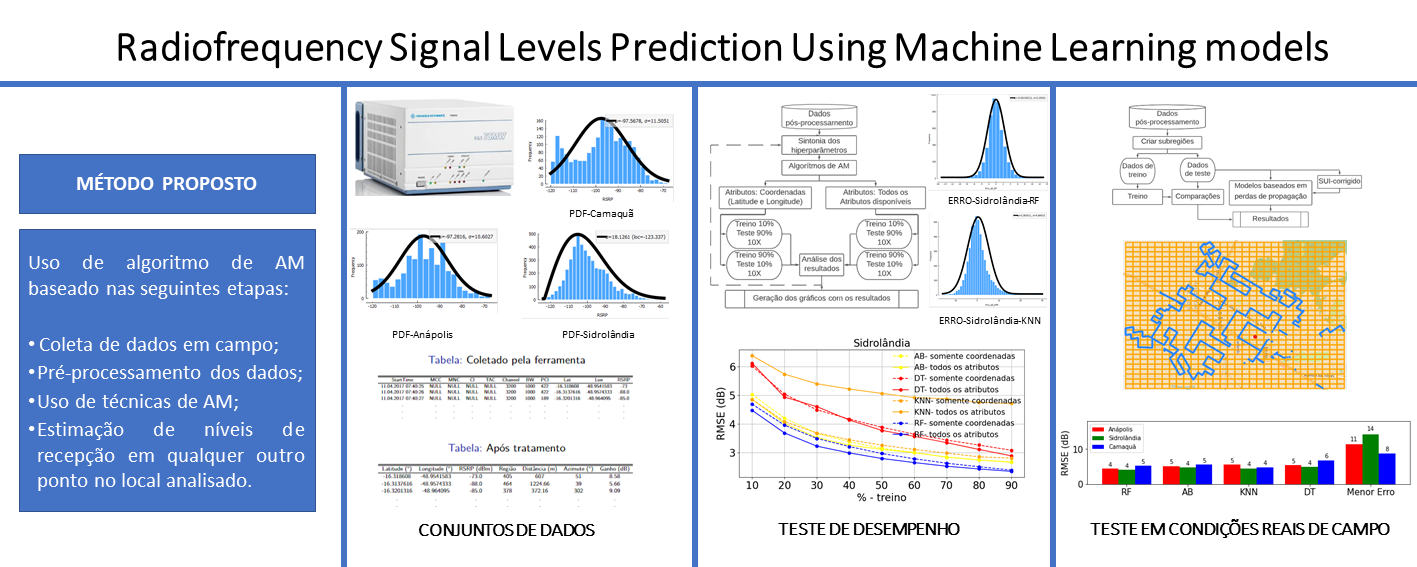Radiofrequency Signal Levels Predition Using Machine Learning Models
Keywords:
Radiofrequency signal levels, machine learning, path loss, mobile comunicationAbstract
Mobile communication is rapidly evolving, generating a demand for networks with high quality and greater capacity. For efficient and reliable network design, it is essential to use accurate reception level prediction models to determine radio network coverage and prevent interference. Traditional models based on path loss propagation have limited accuracy, when used in urban environments, and, especially, when considering the devices' mobility. The main objective of this work is to propose a viable alternative to improve this accuracy with the use of machine learning techniques. The tests carried out in this work show that the use of the random forest technique together with attributes such as: geographic coordinates, distance, azimuth and antenna gain presents good results.
Downloads
References
T. Rappaport, Comunicações sem fio: principios e práticas. Pearson Prentice Hall, 2009.
T. Sarkar, Z. Ji, K. Kim, A. Medouri, and M. Salazar-Palma, “A survey of various propagation models for mobile communication,” IEEE Antennas and Propagation Magazine, vol. 45, no. 3, pp. 51–82, 2003.
ITU-R, “Method for point-to-area predictions for terrestrial services in the frequency range 30 mhz to 3 000 mhz,” Recommendation 1546-6, International Telecommunication Union, Geneva, Aug. 2019.
ITU-R, “A path-specific propagation prediction method for point-to-area terrestrial services in the vhf and uhf bands,” Recommendation 1812-6, International Telecommunication Union, Geneva, Sept. 2021.
P. K. Sharma and R. Singh, “Comparative analysis of propagation path loss models with field measured data,” International Journal of
Engineering Science and Technology, vol. 2, no. 6, pp. 2008–2013, 2010.
P. V. A. De Freitas, Avaliação e Modelagem da Cobertura de Sinal na faixa de 3, 5 GHz para um Ambiente com Clutter. MSc dissertation, Universidade Federal Fluminense, 2021.
C. E. G. Moreta, M. R. C. Acosta, and I. Koo, “Prediction of digital terrestrial television coverage using machine learning regression,” IEEE Transactions on Broadcasting, pp. 1–11, 2019.
E. Alimpertis, A. Markopoulou, C. Butts, and K. Psounis, “Citywide signal strength maps: Prediction with random forests,” in The
World Wide Web Conference, WWW ’19, (New York, NY, USA), p. 2536–2542, Association for Computing Machinery, 2019.
J. Thrane, D. Zibar, and H. L. Christiansen, “Model-aided deep learning method for path loss prediction in mobile communication systems at 2.6 ghz,” IEEE Access, vol. 8, pp. 7925–7936, 2020.
Mitchell, Machine Learning. McGraw Hill, 1997.
A. Cutler, D. R. Cutler, and J. R. Stevens, Random Forests, pp. 157–175.
Boston, MA: Springer US, 2012.
W.-Y. Loh, “Classification and regression trees,” Wiley interdisciplinary reviews: data mining and knowledge discovery, vol. 1, no. 1, pp. 14–23, 2011.
A. Kadiyala and A. Kumar, “Applications of python to evaluate the performance of decision tree-based boosting algorithms,” Environmental Progress & Sustainable Energy, vol. 37, no. 2, pp. 618–623, 2018.
Y. Song, J. Liang, J. Lu, and X. Zhao, “An efficient instance selection algorithm for k nearest neighbor regression,” Neurocomputing, vol. 251, pp. 26–34, 2017.
K. P. Sinaga and M.-S. Yang, “Unsupervised k-means clustering algorithm,”IEEE Access, vol. 8, pp. 80716–80727, 2020.
Rohde&Schwarz, “Universal radio network analyzers user manual,”tech. rep. 1171.5960.32-8, Rohde & Schwarz GmbH & Co. KG, 2017.
Anatel, “Sei pesquisa pública.” Disponível em: https://sei.anatel.gov.br/ sei/modulos/pesquisa/md_pesq_processo_pesquisar.php?acao_externa=protocolo_pesquisar&acao_origem_externa=protocolo_pesquisar&id_orgao_acesso_externo=0. Acesso em: 28 maio, 2022.
Anatel, “Licenciamento de estações.” Disponível em: http://sistemas.anatel.gov.br/se/public/view/b/licenciamento.php. Acesso em: 28 maio, 2022.
ATDI, “Htz communications v22.6.9 modelling all radio communications technologies from 10khz to 350 ghz.” https://atdi.com/
products-and-solutions/htz-communications-for/, 2020.
J. G. e. A. C. P. L. F. d. C. Katti Faceli, ANA CAROLINA LORENA, Inteligência Artificial Uma Abordagem de Aprendizado de Máquina.
LTC, 2019.


